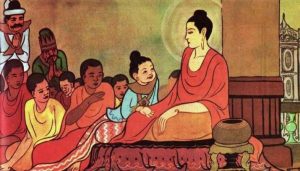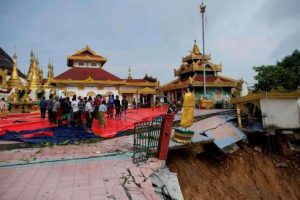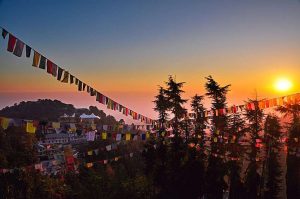
A typical understanding of the afterlife and a poor knowledge of the Pure Land
The Land of Bliss, one of the Buddha’s splendid pure lands for ordinary beings of this world, cannot be visualized with the human eye, although it is one of the best choices for our rebirth after this lifetime, as taught by Shakyamuni Buddha. Shakyamuni introduced Amitabha Buddha and his Land of Bliss in the Infinite Life Sutra, and without prompting revealed to his arhat disciples in a Dharma assembly Amitabha’s teaching of deliverance. Later, in the Contemplation Sutra, the compassionate Buddha responds to a desperate plea made by Queen Vaidehi languishing in prison and advises how she might, as an ordinary being, attain rebirth in the Pure Land.
Having been imprisoned by her own son, who had usurped her husband King Bimbisara’s throne, Queen Vaidehi was so distraught and miserable that she did not want to return to this world in her next life. She thus sought advice from Shakyamuni Buddha as to how she could go to a world in which afflictions and suffering were absent. From the series of requests that Queen Vaidehi made to the Buddha, we know that she was an ordinary person like most of us, with a typically narrow understanding of the afterlife and a poor knowledge of the Pure Land. She had no concept of what the Land of Bliss was—maybe it was simply another heaven, or perhaps a better one. She also had no idea who the Buddha of the Pure Land might be. Although she had heard the name Amitabha, she thought it simply referred to another Buddha, similar to Shakyamuni, in another world. Like many people nowadays, she had no idea why Amitabha Buddha was so special, and had no notion of the difference between the two Buddhas. She made several awkward requests to Shakyamuni Buddha, as follows.
The three requests made by Queen Vaidehi
The first request is outlined in the preface of the Contemplation Sutra: “I only hope [the Buddha] will tell me of a place without afflictions.” It indicates the intention of Queen Vaidehi, who makes a common request in our interest, as an ordinary being in the mundane world. As Queen Vaidehi believed in an afterlife and specifically in reincarnation, she was thinking of a better place in the universe where people suffer no afflictions, such as the four dhyana heavens, which can only be reached through deep meditation (dhyana).
Queen Vaidehi’s second request is: “I hope the Buddha will teach me how to contemplate a place of pure karma.” This request is similar to her first, but is spoken from the point of view of the cause rather than the result. She knew that the dhyana heavens could be accessed through contemplative practices. To become a heavenly being, one must cultivate pure karma such as by practicing the Ten Wholesome Deeds. This is the reason Queen Vaidehi asked the Buddha to teach her how to contemplate a place of pure karma. This second request was also made in the interest of all sentient beings.
Queen Vaihedi’s third request was made after Shakyamuni Buddha projected images of the pure lands for her, including the Land of Bliss. She said to the Buddha: “I am now delighted to be born in Amitabha Buddha’s Land of Bliss. I beseech you to teach me how to perceive (prior to contemplation) [that land] and to teach me how to attain samapatti/samadhi.” This is a special request made by Queen Vaidehi for her personal practice, for the purpose of attaining rebirth in the Land of Bliss.
It should be noted that Queen Vaidehi would have had no way of learning about the pure lands had Shakyamuni Buddha not shown her the images of them. Without Shakyamuni’s guidance, it is unlikely that she would have chosen the Land of Bliss out of the multitude of pure lands.
The implications of the Buddha’s responses to Queen Vaidehi’s requests
Although Shakyamuni Buddha promised Queen Vaidehi that he would tell her how to attain rebirth in the Pure Land through contemplative practices, he reminded her: “You are an ordinary, unenlightened being and so your spiritual powers are weak and obscured. Since you have not yet attained the divine eye, you cannot see that which is distant. But the Buddhas and Tathagatas have special ways to enable you to see far.”
Shakyamuni’s reply has the following important implications:
1. One must possess the divine eye (that is, to have reached the level of understanding of a sage) if one wishes to visualize the Land of Bliss and to be reborn there through meditative practices.
2. The Buddha was unable to “teach” Queen Vaidehi how to contemplate the Land of Bliss; instead, he described what Vaidehi might see if she was able to achieve each of the 13 levels of contemplation, as stated in the Contemplation Sutra.
3. For ordinary beings, the Land of Bliss can be visualized only through the Buddha’s power. There is no other way for us to see, or to be reborn in, the Land of Bliss apart from through the Buddha’s power.
It is interesting to note that the Contemplation Sutra does not elaborate on how we can be reborn in the Land of Bliss through contemplation. Many people are misled by the title of the sutra and may have the impression that it was spoken for those who practice meditative virtues or contemplation for the purpose of being reborn in the Land of Bliss. Nevertheless, the compassionate Buddha took a rare opportunity to skillfully communicate to all sentient beings in this Saha World after his nirvana a tailor-made method in the recitation of Amitabha’s name to ensure their rebirth in the Land of Bliss in their present life.
See more
An Unusual Sutra Revealed (Buddhistdoor Global)











